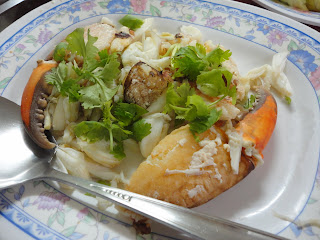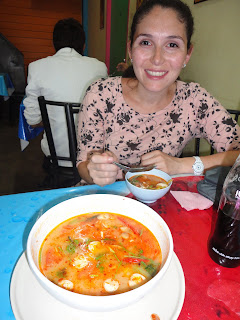I have to admit, the best eats in Southeast Asia, in my opinion, are not found in Laos. However, just because the food is not the best doesn't mean that I didn't love the city that UNESCO declared as a World Heritage Site. The luscious green mountains of the jungle surrounded by the brown flowing waters of the Mekong River engulf the tiny strip of Buddhist spirituality. The chanting of monks can be heard in the early morning and early evening while strolling down the main street dotted with simple Bed and Breakfasts and trendy Boutique Hotels.
After the hustle bustle of Thailand and before the all out craziness of Vietnam, Luang Prabang was a quiet retreat of solitude for Carl and me. The pace of life is pleasantly slow, and the locals seem to walk through the streets without a care in the world. There is no shortage of tourists , but there is no chaos or stress in the site seeing as the real charm of the city is simply being there.
Like the rest of Southeast Asia, I was expecting curries and noodles, soups filled with prawns and squid, and more noodles! I was in a for a bit of a surprise when I found out that their diet is much heartier than that of Thailand, Vietnam or even Cambodia, consisting of sausages, buffalo meat, and stews called "Orlam". Of course, like the rest of Asia, they rely heavily in rice to help artificially fill their bellies during every meal. Rice is the heartbeat of Asia.
During our first evening in Luang Prabang, we found a fabulous restaurant overlooking the main street, and we ordered the two most common typical Lao dishes- Orlam Stew and Buffalo Sausage. As a girl from Texas, I'm used to a greasy sausage with a nice snap accompanying each bite. In Laos, the sausages are completely different. They are tough upon first bite, and the insides lack all remnants of grease, leaving one with a mouthful of gritty shreds of Buffalo meat. The sausage was too tough and dry for my taste, and after finishing one, I chose to leave room in my stomach for the Orlam.
The Orlam was, sadly, disappointing as well. I'm a girl who absolutely loves soups and stews. I've experimented with stews and soups in my slow cooker more times than I'd care to mention, sometimes leaving Carl to finish off a pound and a half of mediocre to inedible concoctions. Needless to say, my excitement about a hearty stew in the middle of Southeast Asia was pretty high! My elation deflated like a popped balloon upon tasting the Orlam, which was predominately overpowered by a strong black licorice flavor (which I found out later is due to the use of a "Holy Basil" plant, which is a key ingredient in many traditional Lao dishes). The one delectable aspect of the stew was the use of elephant ear mushrooms. They are a dark brown mushroom more closely resembling the size and shape of a human ear, but referred to as "elephant ear" mushrooms. I happen to love mushrooms, so the use of this particular mushroom in the dish was quite a treat for me! Otherwise, there appeared to be very little about this dish to rave about. Later in our trip, we participated in a Lao cooking class and learned how to make Orlam, so I'm quite positive that all Orlam is prepared similarly, as both of my attempts at the local favorite tasted equally as disappointing.
There were two traditional dishes that I did thoroughly enjoy! Their green eggplant dip and their traditional Riverweed. We sampled the eggplant dip at two restaurants prior to learning how to make it ourselves at our Lao cooking class. It's a simple concoction, consisting mainly of green eggplant, chilies, and garlic. Each ingredient is seared by an open fire to quickly cook the vegetables and give them a mushier consistency. After they are thoroughly fired, they are all thrown into a mortar and pestle, and ground up to resemble a typical MIddle Eastern Eggplant dip. They look the same, but they taste quite different! Lao eggplant dip has a touch of fire after the initial garlicy goodness. The most surprising part of the eggplant dip is how it's eaten. Accompanied with a bowl of sticky rice, one grabs small balls of sticky rice and dunks them into the eggplant dip, then pops the little ball of rice covered in green eggplant dip into the mouth! It's a snack that's as fun to eat as it is delicious!
Strange as it sounds, the Riverweed was also delicious. Imagine dried strips of seaweed salted and topped with peanuts, and you've got Lao Riverweed. I liked to call it Laos' version of chips and salsa. The Riverweed is dipped into a sweet chili sauce, and eating it brought me right back to any given Tex-Mex restaurant in Texas! Albeit, the Lao Riverweed is hands down a healthier alternative to chips and salsa any day!

Eating the Eggplant Dip at Dyen Sabai in Luang Prabang, Laos

Traditional Lao Riverweed








